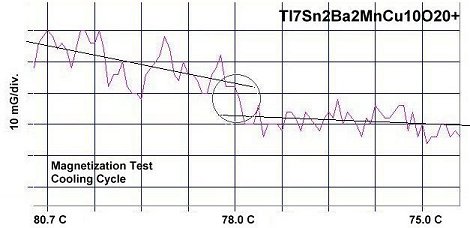
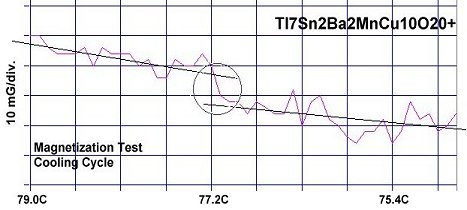


Superconductors.ORG herein reports high Tc has been advanced to 77 Celsius (170F, 350K) with the discovery of the compound Tl7Sn2Ba2MnCu10O20+. This exceedingly high transition temperature (Tc) was achieved by substituting manganese into the titanium atomic sites of the 65 Celsius superconductor announced in January 2014. This substitution increases the dielectric constant (K) of the anion in the "light" region of the H212 structure1 by two orders of magnitude (graphics shown below).
The plots at page top show two examples of the Meissner transitions which consistently appeared near 77C in more than a dozen magnetization tests2. This is the 17th material found to display superconductivity above room temperature.3
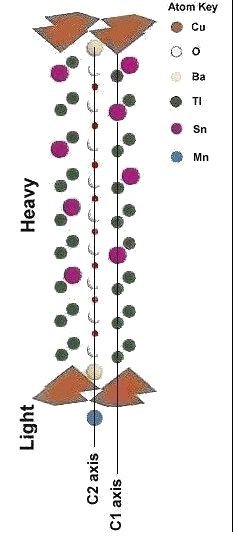
|
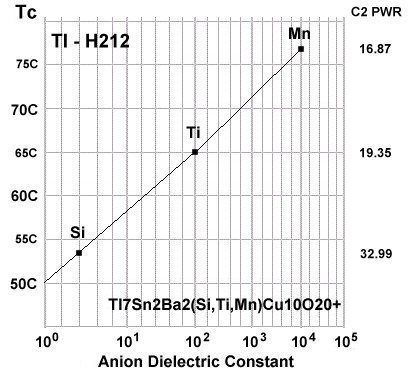
The above graph shows how Tc increases in the H212 structure as the dielectric constant (K) increases exponentially. As dioxides, silicon has a K of only 4, while titanium is near 100 and manganese has a colossal K near 10,000. The rise in Tc occurs despite the planar-weight-ratio (PWR) declining with progressively heavier elements (see right side of graph). Normally Tc goes down as PWR goes down. This discovery provides more support for the theory that superconductivity in the layered cuprates originates in the oxygen layers where PWR is greatest. This is because manganese only comes in contact with the oxygen atoms between the heavy and light regions. |
UPDATE: Resistance tests of this material were difficult due to the brittleness of the pellet. A hardening agent had to be included in the mix that would allow leads to be bonded to the pellet without it breaking apart - and without lowering Tc. A proprietary agent was found4 and included in direct resistance tests performed 4 months after the original magnetization tests. Below are two of those resistance plots that confirm a resistive phase transition is occuring near 77 Celsius. The straight lines represent the average of the data points, skewing apart at Tc.
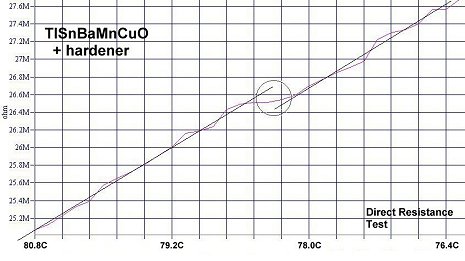
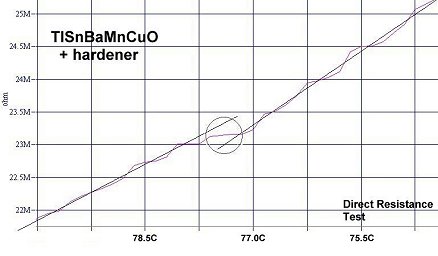
In addition to setting a new world record, this discovery also helps to identify the most efficient combination of elements that can achieve superconductivity at room temperature. Since 77C is more than 50 degrees above room temperature, the unit cell size could be reduced as much as 25-35% and still be superconductive at room temperature. A smaller unit cell size would greatly simplify mass production.
All of the plots on this page exhibit a low signal-to-noise ratio due to a low volume fraction of superconductive material and a high thermal noise level inherent to these temperatures.
This compound was synthesized using the layer cake method, as shown below. The pellet had over 100 interference layers. And, even using this layering technique, the volume fraction is low, requiring very sensitive test equipment.
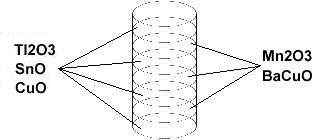
Stoichiometric ratios of the below chemicals were used for the ODD layers:
Tl2O3 99.99% (Alfa Aesar) 7.67 grains...and the below ratios for the EVEN layers.
Mn2O3 98% (Alfa Aesar) .94 grainsThe chemical precursors were pelletized at 60,000 PSI and sintered for 34 hours at 860C. The pellet was then annealed for 10+ hours at 500C in flowing O2. Temperature was determined using an Omega type "T" thermocouple and precision OP77 DC amplifier. The magnetometer employed twin Honeywell SS94A1F Hall-effect sensors with a tandem sensitivity of 50 mv/Gauss.
RESEARCH NOTE: The copper-oxides are strongly hygroscopic. All tests should be performed immediately after annealing.
RE-PUBLICATION NOTICE: Elsevier Publishing, dba Elsevier Science, as well as Morris Communications, both print and broadcast divisions, are specifically prohibited from re-publishing any part of this news story.
E. Joe Eck
© 2014 Superconductors.ORG
All rights reserved.
1. The "H" represents an octodecimal value.
2. Testing temperatures are believed accurate within ± 0.50 degrees C.
3. Materials 5, 6, 8, 11, 12 and 16 are proprietary formulations not yet published, pending patent application.
4. The hardening agent was one atom of antimony substituted into one thallium atomic site.
 BACK to "News" page at Superconductors.ORG
BACK to "News" page at Superconductors.ORG